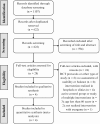A systematic review of exergame usability as home-based balance training tool for older adults usability of exergames as home-based balance training
- PMID: 39172915
- PMCID: PMC11340971
- DOI: 10.1371/journal.pone.0306816
A systematic review of exergame usability as home-based balance training tool for older adults usability of exergames as home-based balance training
Abstract
Background: Exergames are a fun, viable, attractive, and safe way to engage in physical exercise for most patient populations, including older adults. Their use in the home environment enables an expanded understanding about its applicability and its impact on clinical outcomes that can contribute to improved functionality and quality of life in this population. This systematic review aimed to synthesize the evidence on the usability of exergames as a tool for home-based balance training in older adults.
Methods: The search was realized in 6 electronic databases and were included 1) randomized controlled trials with exergames home-based training as intervention, 2) studies involving older adults (aged 60 years or older) described as having impaired static or dynamic balance, 3) that compared the effects of exergames to usual care, health education or no intervention, and 4) reported usability and balance outcomes. The Cochrane Risk of Bias tool for randomized trials version 2 and the Grading of Recommendations Assessment, Development, and Evaluation were used to evaluate the methodological quality of studies and levels of evidence for outcomes.
Results: After screening 1107 records, we identified 4 trials were included. The usability score of exergames was classified as an acceptable, good, and feasible tool. The pooled effect indicated improvements in favor of the exergame group for functional balance by TUG test (MD = -5.90; 95%CI = -10.29 to -1.51) with low-certainty evidence and Tinetti scale (MD = 4.80; 95%CI = 3.36 to 6.24) with very low-certainty evidence. Analyzing the different immersion level, it was observed a significant difference in the experimental group for the immersive exergames (MD = -9.14; 95%CI = -15.51 to -2.77) with very low-certainty evidence.
Conclusion: Exergames applied at home showed good usability and had significant effects on functional balance compared to usual care or no intervention, especially in the immersive modality.
Trial registration: PROSPERO registration number: CRD42022343290.
Copyright: © 2024 Medeiros et al. This is an open access article distributed under the terms of the Creative Commons Attribution License, which permits unrestricted use, distribution, and reproduction in any medium, provided the original author and source are credited.
Conflict of interest statement
The authors have declared that no competing interests exist.
Figures



References
-
- Yeşilyaprak SS, Yildirim MŞ, Tomruk M, Ertekin Ö, Algun ZC. Comparison of the effects of virtual reality-based balance exercises and conventional exercises on balance and fall risk in older adults living in nursing homes in Turkey. Physiother Theory Pract. 2016;32(3):191–201. doi: 10.3109/09593985.2015.1138009 - DOI - PubMed
-
- Horak F. Postural orientation and equilibrium: what do we need to know about neural control of balance to prevent falls? Age Ageing. 2006;35(2):7–11. - PubMed
Publication types
MeSH terms
LinkOut - more resources
Full Text Sources

